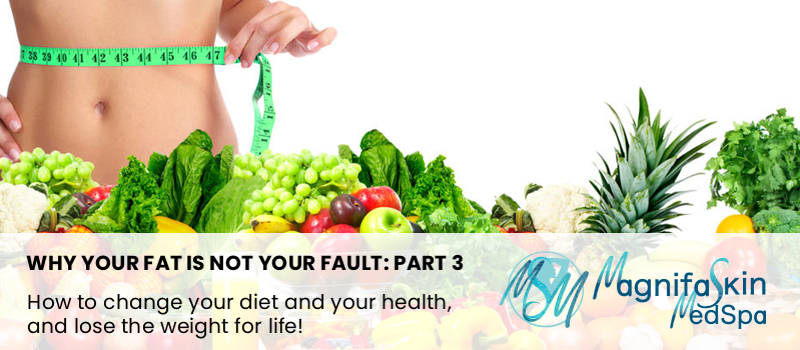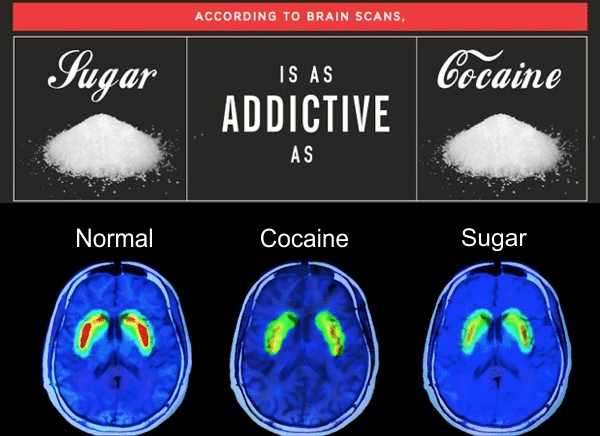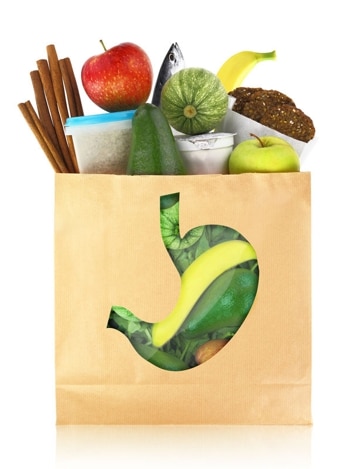
Why Your Fat Is Not Your Fault: Part 3
If you’ve read my last two posts, you now understand exactly how our industrialized, high-sugar diet makes us fat (elevated insulin levels blocking the leptin signal), and why the sugar and processed foods industries removed the fat from our food and replaced it with sugar in the first place. You also know that fructose is toxic, and that fructose, combined with high insulin levels, causes non-alcoholic fatty liver disease (NAFLD), which results in Chronic Metabolic Syndrome, which causes symptoms like diabetes, heart disease, hypertension, hardening of the arteries, high cholesterol, and obesity. In addition, you’ve discovered that while 80% of people who are overweight have NAFLD, so does 40% of the ‘normal weight’ population.
If you haven’t read those posts, I strongly urge you to do so now. Understanding the problem is vital to understanding the solution.
Why Your Fat Is Not Your Fault: Part 1 (How our food supply got poisoned)
Why Your Fat Is Not Your Fault: Part 2 (How sugar is not just making us fat, but slowly killing us)
But It Gets Worse
Before we get into the solution, there’s one last fact you need to know. High sugar diets are addictive. Not just in the sense that we develop a sweet tooth. It’s not just a behavioral addiction. It’s actually a physical addiction, in exactly the same way that opiates like heroin and cocaine are addictive.
Below are brain scans from an opiate addict, and a person who is eating a high sugar diet. The exact same regions within the brain are being stimulated.

As you can see, the scans of a cocaine addict and sugar addict (which is pretty much everyone!) are virtually identical. The same areas of the brain are being stimulated.
This means that if you’ve been eating a high sugar diet for years, or even a diet with a lot of high glycemic index foods, so that your blood sugar levels are constantly elevated, you are addicted. Just as telling a cocaine addict to simply stop snorting coke won’t work, neither can the average person simply stop eating sugar and high glycemic index foods. The lack of leptin signal is constantly telling your brain that you are starving. The result of this is a survival response – Eat or die. No one has the kind of willpower necessary to ignore that signal for long.
Why Diets Don’t Work
You may have tried dieting in the past. Perhaps you lost some weight. Perhaps you didn’t. If you did, though, it’s almost certain that you eventually gained it all back. Why?
When we diet, we short ourselves calories, forcing our body to burn fat to make up for the energy deficit. It’s really difficult because dieting makes us hungry, denies us the foods we’re used to and love, and requires us to make radical changes to our eating habits. All of this takes willpower and determination.
And while diets will result in weight loss, they also cause a great deal of harm. Our body wants to keep its fat. Fat is survival insurance. Our body will burn pretty much anything it can before burning any substantial amount of fat. Burning fat is a last resort.
If we’re eating a low-calorie diet, often through the traditional method of smaller meals and lower-calorie foods, we’re still telling our body to burn glucose. But because we’re not giving it enough glucose, it’s going to try to get more. Our body can burn its own muscle tissue in a process called gluconeogenesis. This means it breaks down proteins to make glucose for energy. This results in muscle loss, and that’s a metabolic disaster!

We’ve been told for decades that cardio exercise is the way to burn fat. Unfortunately, it doesn’t work. Studies show that on average a dedicated program of cardio exercise results in an average reduction in BMI of 1%. This, of course, leads people to get discouraged and give up. They exercise, but they don’t lose the fat.
Why Losing Muscle is Really Bad!
The best way to avoid gaining fat is to burn a lot of calories. The truth is that exercise really doesn’t do a good job of this. Just to burn off one Big Mac, we would have to run (not jog – run!) for about 90 minutes. Exercise is very ineffective for burning fat. I know this will surprise a lot of you because you’ve been told your whole life that cardio is the way to burn fat. However, multiple studies have shown this simply isn’t true. While any exercise is better than none, the benefits of cardio exercise don’t include effectively controlling our weight.
So how do we burn more calories?
By having more muscle. Muscle is three times as metabolically active as fat. The more muscle we have, the more calories we burn just being alive. This is called our Basal Metabolic Rate, and BMR is the largest factor in determining how many calories we burn just being alive. So losing muscle is really bad because it lowers our BMR.
How Diets Set You Up To Fail
When you diet, you lose muscle. This lowers your BMR, which means you’re burning fewer calories than you were before you went on the diet. Then you reach your target weight and slowly go back to eating the way you used to. Except now, your body needs fewer calories. If you lost only enough muscle to lower your BMR by 100 calories per day, you would now regain fat at a faster rate. Almost one pound per month faster, assuming the same caloric intake you had before your diet. One pound per month is 12 pounds per year. That adds up fast!
Dietary Aside
The Atkins Diet. The Paleo Diet. The Keto Diet. Which one works best? The fact is, they all work, and for the same reason. They are all low-sugar, low-processed-foods diets. They work because they get the sugar out of your diet and replace it with healthy food, lowering the insulin levels, stopping fat storage, and letting the leptin signal through.
This is why almost everyone who loses weight on a diet will eventually gain it all back, and many people will end up fatter than they were before they went on the diet. Never, ever diet. They don’t work. Period.
So What Does Work?
If you want to make a permanent change in your body, you must adopt a permanent change to your lifestyle. This means that any temporary change in your diet will result in a temporary change to your body. So how do we permanently change our eating habits, lose the weight, and keep it off for life? Remember, the high sugar diet is addictive. You can’t just change your diet for life overnight. If you try, you will almost certainly fail.
Start By Adding Something, Not Taking Something Away
OK, we want to cut out the sugar and processed foods, but there are two problems. First, we’re addicted. Second, we’ve gotten used to a diet that keeps our blood sugar elevated, raising insulin levels to the point where the leptin signal can’t get through. This triggers an ‘Eat or Die’ survival response. If this sounds like an almost impossible combination to beat, you’re right. This won’t be easy, but if you follow the right steps, it can be done.

Dietary fiber is the key to breaking the cycle. The fiber slows digestion, which results in lower insulin levels, which in turn lets the leptin signal through.
The Secret Weapon: Fiber
We all know that dietary fiber is that tasteless stuff in vegetables, whole grains and some fruits that helps to ‘keep us regular’. That’s nice. When we’re faced with that box of donuts, do we really care if we’re not going to quite poop right tomorrow? Of course not. Even I don’t care. I like donuts.
But fiber does something else, and that something else is the key to turning things around. Fiber slows the digestion of foods. When we slow digestion, we slow the release of glucose. This slows the release of insulin, resulting in lower insulin levels. That minimizes fat storage and lets the leptin signal through!
The vital first step is adding fiber to every meal.
Every. Meal.
You’ll be less hungry, find yourself eating less often, and your energy levels will go up. In short, you’ll start to move more and eat less without even thinking about it. The only self-discipline required is remembering to add fiber.
The Next Steps
Now that you’ve got more energy and you’re eating less, and you’ve largely shut down any new fat storage due to lower insulin levels, how do you shed the fat you’re already carrying? This would take far more space than I have here to cover completely, but I can start you in the right direction with some general guidelines.
The Key to A lifelong Change
You absolutely must get the high-sugar, highly-processed-foods out of your diet and replace them with healthy, whole foods. This is essential to lifelong success. Remember, any permanent change in your body requires a permanent change in your lifestyle.
Start Cooking
If you’re in the habit of eating from restaurants or popping pre-prepared food in the oven or microwave, you’ll need to gradually replace this habit with cooking your own food. I know some of you are saying, ‘But I don’t have time’. If you’re too busy to cook every day, you can prepare meals on the weekend, then freeze them for later in the week. You might also be surprised by this statistic: people who cook from scratch, on average, only spend 10 to 20 minutes more per day on food prep. Cooking from scratch does not have to mean a three-course meal that takes hours. The difference between having whole oats, eggs, and fruit for breakfast versus cereal is only a few minutes.
Change Food Habits Gradually
Make a list of the foods you commonly eat. Note the ones that are unhealthy. Read the labels. If it’s more than 3% sugar or has a lot of processed grains (usually in the form of flour), you don’t want to be eating it. Learn about glycemic index, and gradually purge from your diet any foods with a glycemic index higher than 65.
Now that you have your list, identify the food you’ll miss the least. Maybe it’s cereal, maybe it’s bread, or maybe it’s Starbucks Lattes. Whatever it is, start with that one. Remove it from your diet. Give yourself at least six weeks to get used to this change before moving on to the next item on the list.
Don’t try to rush it. If you try to make too many changes in too short a time, you’ll almost certainly fail. Cravings and force of habit will derail your efforts. Remember you’re making a life-long change. Give it time. You’ve been eating that diet for your whole life to this point. Changing it won’t be easy, and it won’t happen quickly. I was already eating a fairly healthy diet when I learned all of this, and it still took me two years to fully switch to a healthy, whole foods diet without craving the potato chips and chocolate bars that used to be a part of my daily diet.
Don’t Forget the Fiber
Above all, remember to add fiber. I can’t stress this enough. Slowing the food absorption and lowering your insulin level is essential to success. Find high fiber foods you like so that eating them won’t be a discipline but a pleasure. Whole oats, blueberries, and homemade guacamole are high on my list.
Here’s an excellent list of 22 high fiber foods to get you started.
A Deeper Understanding
In these three posts, I’ve given you a very quick overview of the cause of the global obesity epidemic. By now, you know that obesity is just a symptom of something better referred to as Chronic Metabolic Syndrome. CMS results from the industrialized diet that is now being exported around the world. In the past 20 years, CMS and the health issues that result from it have become a larger problem in the developing world than starvation and malnutrition. (Although, CMS should be seen as malnutrition too). And of course, in the industrialized world, it’s an epidemic. The whole world is getting sicker every year and if you’ve read this far chances are good you are also a victim.
If nothing else, what I want you to take away from all this is that you are not the problem! Your fat is not your fault. Your food supply has been poisoned. It’s an environmental problem, not a personal failure.
This overview only scratches the surface though. There are many resources available that will give you a much deeper understanding of CMS, the global obesity epidemic, and how to permanently change your body and improve your health for life. One of the best resources is the book Fat Chance, by Dr. Robert Lustig. You can also refer to his many videos online, stating with his series The Skinny on Obesity. To find out how the sugar industry set us all up to fail, you can watch the excellent documentary, Sugar Coated.
Beauty is not skin deep. It starts with a healthy diet and active lifestyle. MagnifaSkin wants you to be healthy and happy. When you are, beauty will follow naturally.

Be the first to know about new Specials, and blog posts with valuable free information on skin care, beauty and wellness. Sign up below and you'll receive an email notice of new specials as well as new posts. You can unsubscribe at any time.


